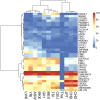Copy number variation in Thai population
- PMID: 25118596
- PMCID: PMC4131886
- DOI: 10.1371/journal.pone.0104355
Copy number variation in Thai population
Abstract
Copy number variation (CNV) is a major genetic polymorphism contributing to genetic diversity and human evolution. Clinical application of CNVs for diagnostic purposes largely depends on sufficient population CNV data for accurate interpretation. CNVs from general population in currently available databases help classify CNVs of uncertain clinical significance, and benign CNVs. Earlier studies of CNV distribution in several populations worldwide showed that a significant fraction of CNVs are population specific. In this study, we characterized and analyzed CNVs in 3,017 unrelated Thai individuals genotyped with the Illumina Human610, Illumina HumanOmniexpress, or Illumina HapMap550v3 platform. We employed hidden Markov model and circular binary segmentation methods to identify CNVs, extracted 23,458 CNVs consistently identified by both algorithms, and cataloged these high confident CNVs into our publicly available Thai CNV database. Analysis of CNVs in the Thai population identified a median of eight autosomal CNVs per individual. Most CNVs (96.73%) did not overlap with any known chromosomal imbalance syndromes documented in the DECIPHER database. When compared with CNVs in the 11 HapMap3 populations, CNVs found in the Thai population shared several characteristics with CNVs characterized in HapMap3. Common CNVs in Thais had similar frequencies to those in the HapMap3 populations, and all high frequency CNVs (>20%) found in Thai individuals could also be identified in HapMap3. The majorities of CNVs discovered in the Thai population, however, were of low frequency, or uniquely identified in Thais. When performing hierarchical clustering using CNV frequencies, the CNV data were clustered into Africans, Europeans, and Asians, in line with the clustering performed with single nucleotide polymorphism (SNP) data. As CNV data are specific to origin of population, our population-specific reference database will serve as a valuable addition to the existing resources for the investigation of clinical significance of CNVs in Thais and related ethnicities.
Conflict of interest statement
Figures




Similar articles
-
Identification of genome-wide copy number variations and a family-based association study of Avellino corneal dystrophy.Ophthalmology. 2010 Jul;117(7):1306-12.e4. doi: 10.1016/j.ophtha.2009.11.021. Epub 2010 Mar 3. Ophthalmology. 2010. PMID: 20202685
-
Copy number variations in the genome of the Qatari population.BMC Genomics. 2015 Oct 22;16:834. doi: 10.1186/s12864-015-1991-5. BMC Genomics. 2015. PMID: 26490036 Free PMC article.
-
CNV analysis in the Lithuanian population.BMC Genet. 2016 May 4;17(1):64. doi: 10.1186/s12863-016-0373-6. BMC Genet. 2016. PMID: 27142071 Free PMC article.
-
DNA copy number variation: Main characteristics, evolutionary significance, and pathological aspects.Biomed J. 2021 Oct;44(5):548-559. doi: 10.1016/j.bj.2021.02.003. Epub 2021 Feb 13. Biomed J. 2021. PMID: 34649833 Free PMC article. Review.
-
Replication stress and mechanisms of CNV formation.Curr Opin Genet Dev. 2012 Jun;22(3):204-10. doi: 10.1016/j.gde.2012.01.009. Epub 2012 Feb 23. Curr Opin Genet Dev. 2012. PMID: 22365495 Free PMC article. Review.
Cited by
-
Large-scale deletions of the ABCA1 gene in patients with hypoalphalipoproteinemia.J Lipid Res. 2018 Aug;59(8):1529-1535. doi: 10.1194/jlr.P086280. Epub 2018 Jun 4. J Lipid Res. 2018. PMID: 29866657 Free PMC article.
-
MYT1L: A systematic review of genetic variation encompassing schizophrenia and autism.Am J Med Genet B Neuropsychiatr Genet. 2020 Jun;183(4):227-233. doi: 10.1002/ajmg.b.32781. Epub 2020 Apr 8. Am J Med Genet B Neuropsychiatr Genet. 2020. PMID: 32267091 Free PMC article.
-
Genetic diagnosis for adult patients at a genetic clinic.Cold Spring Harb Mol Case Stud. 2022 Dec 28;8(7):a006235. doi: 10.1101/mcs.a006235. Print 2022 Dec. Cold Spring Harb Mol Case Stud. 2022. PMID: 36265913 Free PMC article.
-
A comprehensive analysis of copy number variation in a Turkish dementia cohort.Hum Genomics. 2021 Jul 28;15(1):48. doi: 10.1186/s40246-021-00346-z. Hum Genomics. 2021. PMID: 34321086 Free PMC article.
-
Influence of genetic copy number variants of the human GLUT3 glucose transporter gene SLC2A3 on protein expression, glycolysis and rheumatoid arthritis risk: A genetic replication study.Mol Genet Metab Rep. 2019 Apr 6;19:100470. doi: 10.1016/j.ymgmr.2019.100470. eCollection 2019 Jun. Mol Genet Metab Rep. 2019. PMID: 30997344 Free PMC article.
References
Publication types
MeSH terms
LinkOut - more resources
Full Text Sources
Other Literature Sources
Research Materials

